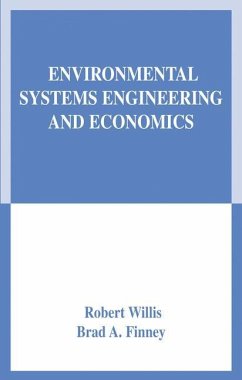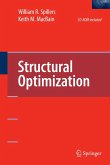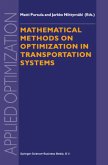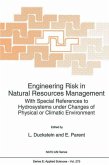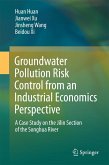- Gebundenes Buch
- Merkliste
- Auf die Merkliste
- Bewerten Bewerten
- Teilen
- Produkt teilen
- Produkterinnerung
- Produkterinnerung
Environmental Systems Engineering and Economics emphasizes the application of optimization, economics, and systems engineering to problems in environmental resources management. This senior level/graduate textbook introduces optimization theory and algorithms that have been successful in resolving water quality and groundwater management problems. Both linear programming and nonlinear optimization are presented. Multiobjective optimization and the linked simulation-optimization (LSO) methodology are also introduced. The basic principles of economics and engineering economics are also…mehr
Andere Kunden interessierten sich auch für
![Environmental Systems Engineering and Economics Environmental Systems Engineering and Economics]() Robert WillisEnvironmental Systems Engineering and Economics39,99 €
Robert WillisEnvironmental Systems Engineering and Economics39,99 €![Structural Optimization Structural Optimization]() William R. SpillersStructural Optimization82,99 €
William R. SpillersStructural Optimization82,99 €![Structural Optimization Structural Optimization]() William R. SpillersStructural Optimization112,99 €
William R. SpillersStructural Optimization112,99 €![Mathematical Methods on Optimization in Transportation Systems Mathematical Methods on Optimization in Transportation Systems]() M. Pursula / Jarko Niittymäki (Hgg.)Mathematical Methods on Optimization in Transportation Systems115,99 €
M. Pursula / Jarko Niittymäki (Hgg.)Mathematical Methods on Optimization in Transportation Systems115,99 €![Mathematical Methods on Optimization in Transportation Systems Mathematical Methods on Optimization in Transportation Systems]() Mathematical Methods on Optimization in Transportation Systems112,99 €
Mathematical Methods on Optimization in Transportation Systems112,99 €![Engineering Risk in Natural Resources Management Engineering Risk in Natural Resources Management]() Engineering Risk in Natural Resources Management223,99 €
Engineering Risk in Natural Resources Management223,99 €![Groundwater Pollution Risk Control from an Industrial Economics Perspective Groundwater Pollution Risk Control from an Industrial Economics Perspective]() Huan HuanGroundwater Pollution Risk Control from an Industrial Economics Perspective82,99 €
Huan HuanGroundwater Pollution Risk Control from an Industrial Economics Perspective82,99 €-
-
-
Environmental Systems Engineering and Economics emphasizes the application of optimization, economics, and systems engineering to problems in environmental resources management. This senior level/graduate textbook introduces optimization theory and algorithms that have been successful in resolving water quality and groundwater management problems. Both linear programming and nonlinear optimization are presented. Multiobjective optimization and the linked simulation-optimization (LSO) methodology are also introduced. The basic principles of economics and engineering economics are also discussed to provide a framework for economic decision making. This text contains numerous example problems. Case studies are presented that address water resources management issues in the north China plain, the control of saltwater intrusion in Jakarta, Indonesia, and groundwater resources management in the Yun Lin basin, Taiwan.
Produktdetails
- Produktdetails
- Verlag: Springer / Springer Netherlands / Springer US
- Artikelnr. des Verlages: 978-1-4020-7669-5
- 2004
- Seitenzahl: 488
- Erscheinungstermin: 30. November 2003
- Englisch
- Abmessung: 241mm x 160mm x 31mm
- Gewicht: 939g
- ISBN-13: 9781402076695
- ISBN-10: 140207669X
- Artikelnr.: 14072495
- Herstellerkennzeichnung
- Springer-Verlag GmbH
- Tiergartenstr. 17
- 69121 Heidelberg
- ProductSafety@springernature.com
- Verlag: Springer / Springer Netherlands / Springer US
- Artikelnr. des Verlages: 978-1-4020-7669-5
- 2004
- Seitenzahl: 488
- Erscheinungstermin: 30. November 2003
- Englisch
- Abmessung: 241mm x 160mm x 31mm
- Gewicht: 939g
- ISBN-13: 9781402076695
- ISBN-10: 140207669X
- Artikelnr.: 14072495
- Herstellerkennzeichnung
- Springer-Verlag GmbH
- Tiergartenstr. 17
- 69121 Heidelberg
- ProductSafety@springernature.com
1. Introduction to Environmental Systems Engineering.- 1.1 Introduction.- 1.2 Systems Engineering.- 1.3 Mathematical Models.- 1.4 The Systems Engineering Problem.- 1.5 Systems Engineering Problems.- 1.6 The Model Building Process.- 1.7 Simulation Modeling.- 1.8 Optimization Modeling.- References.- Problems.- 2. An Introduction to Optimization Theory.- 2.1 Introduction.- 2.2 Classification of Optimization Models.- 2.3 Geometry of the Mathematical Optimization Problem.- 2.4 Nonlinear Optimization and Types of Maxima.- 2.5 Convex Sets and Functions.- 2.6 Weierstrass Theorems.- 2.7 The Local-Global Theorem.- 2.8 The Kuhn-Tucker Conditions.- 2.9 The Kuhn-Tucker Theorem.- 2.10 Interpretation of the Lagrange Multipliers.- 2.11 The Saddle Point Problem.- 2.12 Maximin Dual Problem.- References.- Problems.- 3. Microeconomics: Theory of Production.- 3.1 Introduction.- 3.2 The Competitive Economy.- 3.3 The Production Function.- 3.4 Theory of the Firm.- 3.5 Maximum Output Model.- 3.6 Production Optimization.- 3.7 Comparative Statics of the Firm.- 3.8 Public Project Evaluation.- 3.9 Case Study 1- Agricultural Benefits.- References.- Problems.- 4. Microeconomics: Theory of the Household.- 4.1 Introduction.- 4.2 Commodity Space and Preference Relations.- 4.3 Theory of the Household.- 4.4 Comparative Statics.- 4.5 General Equilibrium.- 4.6 Market Equilibrium.- References.- Problems.- 5. Engineering Economics.- 5.1 Introduction.- 5.2 The Time Value of Money.- 5.3 Engineering Economic Formulas.- 5.4 Evaluation of Alternatives.- 5.5 Present Worth Method.- 5.6 Annual Worth Method.- 5.7 Benefit Cost Ratio.- 5.8 Internal Rate of Return.- 5.9 Depreciation and Income Tax Analysis.- 5.10 Inflation.- References.- Problems.- 6. Linear Programming.- 6.1 Introduction.- 6.2 Optimality of LinearProgramming Problems.- 6.3 Standard Form.- 6.4 Basic and Basic Feasible Solutions.- 6.5 The Simplex Algorithm.- 6.6 The Simplex Tableau.- 6.7 The Two-Phase Method.- 6.8 General Summary of the Simplex Algorithm.- 6.9 Duality.- 6.10 Matrix Representation of the Simplex Method.- 6.11 Economic Interpretation of the Dual Problem.- 6.12 The Revised Simplex Method.- 6.13 Sensitivity Analysis.- 6.14 Large-Scale Linear Programming Models.- 6.15 Case Study 1 Groundwater Planning.- References.- Problems.- 7. Nonlinear Programming.- 7.1 Introduction.- 7.2 Unconstrained Optimization Methods.- 7.3 Gradient-Based Methods.- 7.4 Constrained Optimization Methods.- 7.5 Case Study 1 North China Plain Water Management.- 7.6 Dynamic Programming.- 7.7 Case Study 2 Water Quality Management.- 7.8 linked Simulation-Optimization Methodology.- 7.9 Case Study 3 Management of Saltwater Intrusion.- 7.10 Case Study 4 Groundwater Remediation.- 7.11 Multiobjective Optimization.- 7.12 Case Study 5 Equity in Water Quality Management.- References.- Problems.- Appendix A. Review of Mathematics.- A.1 Introduction.- A.2 Analysis.- A.3 Vectors and Matrices.- A.4 Matrix Operations.- A.5 Determinants and the Matrix Inverse.- A.6 Quadratic Forms.- A.7 Scalar, Vector, and Matrix Derivatives.- A.8 Directional Derivative.- A.9 Eigenvalues and Eigenvectors.- A.10 Implicit Function Theorem.- A.ll Taylor Series.- A.12 Leibnitz's Rule.- References.- Appendix B. Classical Optimization.- B.1 Introduction.- B.2 The Unconstrained Optimization Problem.- B.3 The Lagrange Multiplier Method.- B.4 The Lagrange Multiplier.- References.
1. Introduction to Environmental Systems Engineering.- 1.1 Introduction.- 1.2 Systems Engineering.- 1.3 Mathematical Models.- 1.4 The Systems Engineering Problem.- 1.5 Systems Engineering Problems.- 1.6 The Model Building Process.- 1.7 Simulation Modeling.- 1.8 Optimization Modeling.- References.- Problems.- 2. An Introduction to Optimization Theory.- 2.1 Introduction.- 2.2 Classification of Optimization Models.- 2.3 Geometry of the Mathematical Optimization Problem.- 2.4 Nonlinear Optimization and Types of Maxima.- 2.5 Convex Sets and Functions.- 2.6 Weierstrass Theorems.- 2.7 The Local-Global Theorem.- 2.8 The Kuhn-Tucker Conditions.- 2.9 The Kuhn-Tucker Theorem.- 2.10 Interpretation of the Lagrange Multipliers.- 2.11 The Saddle Point Problem.- 2.12 Maximin Dual Problem.- References.- Problems.- 3. Microeconomics: Theory of Production.- 3.1 Introduction.- 3.2 The Competitive Economy.- 3.3 The Production Function.- 3.4 Theory of the Firm.- 3.5 Maximum Output Model.- 3.6 Production Optimization.- 3.7 Comparative Statics of the Firm.- 3.8 Public Project Evaluation.- 3.9 Case Study 1- Agricultural Benefits.- References.- Problems.- 4. Microeconomics: Theory of the Household.- 4.1 Introduction.- 4.2 Commodity Space and Preference Relations.- 4.3 Theory of the Household.- 4.4 Comparative Statics.- 4.5 General Equilibrium.- 4.6 Market Equilibrium.- References.- Problems.- 5. Engineering Economics.- 5.1 Introduction.- 5.2 The Time Value of Money.- 5.3 Engineering Economic Formulas.- 5.4 Evaluation of Alternatives.- 5.5 Present Worth Method.- 5.6 Annual Worth Method.- 5.7 Benefit Cost Ratio.- 5.8 Internal Rate of Return.- 5.9 Depreciation and Income Tax Analysis.- 5.10 Inflation.- References.- Problems.- 6. Linear Programming.- 6.1 Introduction.- 6.2 Optimality of LinearProgramming Problems.- 6.3 Standard Form.- 6.4 Basic and Basic Feasible Solutions.- 6.5 The Simplex Algorithm.- 6.6 The Simplex Tableau.- 6.7 The Two-Phase Method.- 6.8 General Summary of the Simplex Algorithm.- 6.9 Duality.- 6.10 Matrix Representation of the Simplex Method.- 6.11 Economic Interpretation of the Dual Problem.- 6.12 The Revised Simplex Method.- 6.13 Sensitivity Analysis.- 6.14 Large-Scale Linear Programming Models.- 6.15 Case Study 1 Groundwater Planning.- References.- Problems.- 7. Nonlinear Programming.- 7.1 Introduction.- 7.2 Unconstrained Optimization Methods.- 7.3 Gradient-Based Methods.- 7.4 Constrained Optimization Methods.- 7.5 Case Study 1 North China Plain Water Management.- 7.6 Dynamic Programming.- 7.7 Case Study 2 Water Quality Management.- 7.8 linked Simulation-Optimization Methodology.- 7.9 Case Study 3 Management of Saltwater Intrusion.- 7.10 Case Study 4 Groundwater Remediation.- 7.11 Multiobjective Optimization.- 7.12 Case Study 5 Equity in Water Quality Management.- References.- Problems.- Appendix A. Review of Mathematics.- A.1 Introduction.- A.2 Analysis.- A.3 Vectors and Matrices.- A.4 Matrix Operations.- A.5 Determinants and the Matrix Inverse.- A.6 Quadratic Forms.- A.7 Scalar, Vector, and Matrix Derivatives.- A.8 Directional Derivative.- A.9 Eigenvalues and Eigenvectors.- A.10 Implicit Function Theorem.- A.ll Taylor Series.- A.12 Leibnitz's Rule.- References.- Appendix B. Classical Optimization.- B.1 Introduction.- B.2 The Unconstrained Optimization Problem.- B.3 The Lagrange Multiplier Method.- B.4 The Lagrange Multiplier.- References.

